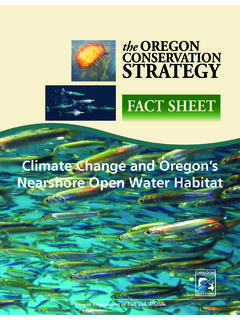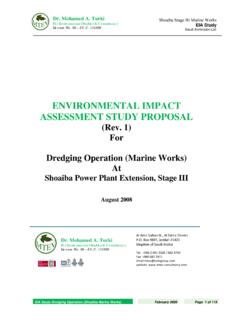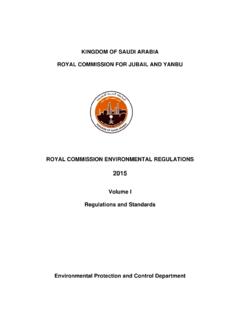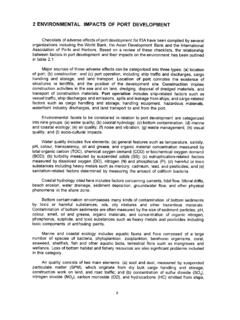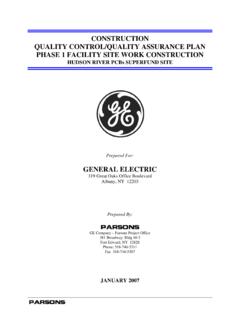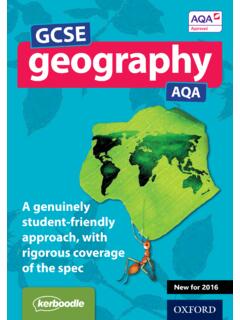Transcription of Chapter 7: Factors Affecting Species and Habitats
1 Chapter 7: Factors Affecting Species and Habitats 2016 Oregon Department of Fish and Wildlife Oregon Nearshore Strategy 2016: Factors Affecting Species and Habitats -i Table of Contents Chapter 7: Factors Affecting Species and Habitats Factors Affecting Species AND Habitats .. 1 CLIMATE CHANGE AND OCEAN ACIDIFICATION .. 6 WATER QUALITY DEGRADATION .. 6 ALTERATION OR LOSS OF 7 ALTERATION OF OCEANOGRAPHIC REGIMES .. 8 OVEREXPLOITATION .. 9 NOISE POLLUTION .. 9 OIL SPILLS .. 10 INVASIVE Species .. 10 WILDLIFE DISTURBANCE .. 12 HARMFUL ALGAL BLOOMS .. 12 DISEASE .. 12 SENSITIVITY TO ADVERSE EFFECTS FROM NATURAL AND ANTHROPOGENIC Factors .. 13 STRATEGY SPOTLIGHT: OCEAN ACIDIFICATION.
2 21 PDF Content Last Updated January 3, 2017 This PDF is a Chapter of the Oregon Nearshore Strategy, the marine component of the official State Wildlife Action Plan for Oregon. The complete Oregon Conservation Strategy is available online at Since Conservation Strategy content will be updated periodically, please check the website to ensure that you are using the most current version of downloadable files. Contact ODFW For more information on the Oregon Nearshore Strategy or to provide comments, email or write to Oregon Department of Fish and Wildlife, Marine Resources Program 2040 SE Marine Science Drive, Newport, OR 97365 Oregon Nearshore Strategy 2016: Factors Affecting Species and Habitats -ii Recommended Citation Oregon Nearshore Strategy.
3 2016. Oregon Department of Fish and Wildlife, Salem, Oregon. Cover Photos Banner: Copper Rockfish, Janna Nichols; Red Sea Urchin, Scott Groth; Black Oystercatcher, Kelsey Adkisson; Steller Sea Lions, ODFW; Bull Kelp, Janna Nichols; Wolf Eel, Taylor Frierson Feature image: Harmful algal bloom bubbles wash ashore, ODFWO regon Nearshore Strategy 2016: Factors Affecting Species and Habitats -1 As human populations and activities in and around Oregon nearshore waters increase, so too do the impacts on fish, wildlife and the Habitats they utilize. The Factors Affecting Species and their Habitats are often intertwined, and anthropogenic impacts may be exacerbated by naturally occurring processes.
4 This Chapter identifies Factors that could adversely affect key nearshore Habitats and Species , and possibly require management action. Cumulative impacts should be considered in addition to individual effects. The list of the Factors Affecting Strategy Species and their Habitats initially developed for the original Nearshore Strategy has been revised here in light of new information from scientific literature and input from researchers, subject matter experts, and the public. Over the last decade, new research has provided a better understanding of Factors that may impact Oregon s nearshore environment. For example, ongoing research on the impacts of global climate change and ocean acidification to organisms and Habitats in Oregon s nearshore waters is beginning to describe the far-reaching effects of these stressors (Figure ).
5 Impacts of the increase of atmospheric carbon dioxide and other greenhouse gasses on the marine environment include, but are not limited to, increasing ocean temperatures, sea level rise, changing circulation and weather patterns, and changes in ocean chemistry all of which may affect Species and their Habitats (Bindoff et al. 2007, Osgood 2008, Brierley and Kingsford 2009, Hixon et al. 2010, Mote et al. 2010, Hoegh-Guldberg and Bruno 2010, Rhein et al. 2013). There are new analyses that provide insight into the vulnerability of many Species to overfishing (Essington et al. 2015, PFMC 2014), and to its effects on ecosystems. There is more information available about sustainable levels of harvest and fishing practices (Dick and McCall 2010, Essington et al.)
6 2015). Additionally, new resource issues have arisen in the last ten years that could potentially affect Species , Habitats and biological communities. For example, the widespread emergence of sea star wasting syndrome along the west coast and the work on offshore renewable energy development have raised conservation concerns in Oregon since 2006. Table and text briefly summarize the natural and anthropogenic Factors that impact Strategy Species and their Habitats , along with the potential sources of those Factors . Factors Affecting Species AND Habitats Photo Credit: ODFW Oregon Nearshore Strategy 2016: Factors Affecting Species and Habitats -2 Figure Diagram depicting the effects of increased atmospheric carbon dioxide on global oceans including Oregon s coastal and nearshore environments and the Species living there.
7 Oregon Nearshore Strategy 2016: Factors Affecting Species and Habitats -3 Table Factors Affecting Nearshore Strategy Species and Habitats Natural Factors Potential Sources Alteration of oceanographic regimes El Ni o La Ni a Droughts (alters freshwater inflow) Pacific Decadal Oscillation Disease and biotoxins Harmful algal blooms Sea star wasting syndrome Loss / alteration of habitat Earthquakes / tsunamis / volcanic eruptions Large storms Droughts (alters freshwater inflow) Water quality degradation Hypoxia events Naturally occurring toxic compounds such as arsenic Anthropogenic Factors Potential Sources Invasive Species (including disease introduction) Aquaculture Aquarium pet trade Research facilities and public aquariums Some fishing operations ( , herring roe which may entail importing kelp on which the roe can be deposited) Transport of live animals and plants Vessel operations / transportation / navigation Ballast water Loss / alteration of habitat and oceanographic regimes Agriculture and forestry practices Altered freshwater inflow (created by dams upstream, etc.)
8 Artificial reefs Aquaculture Beach grooming Climate change (global warming) o Increased air and water temperature o Changes in upwelling and ocean circulation patterns o Sea level rise o Altered river inputs o Larger storm events (coastal erosion) o Ocean acidification and hypoxia o Ocean stratification o Erosion Beach nourishment Oregon Nearshore Strategy 2016: Factors Affecting Species and Habitats -4 Table Factors Affecting Nearshore Strategy Species and Habitats Coastal and estuary development dredging and dredged material disposal Diking Fishing methods and gear (including derelict gear) Fish processing waste (increased turbidity and surface plumes) Harvest of habitat-forming organisms ( , kelp, mussels) In water structures ( , jetties, seawalls) Marine mining Oil / gas exploration / development / production Offshore renewable energy development Overwater structures ( , mooring buoys, floating docks)
9 Point source discharge Removal, resulting in loss, of keystone Species Submarine cable and pipeline installation Trampling (on rocky intertidal) Vessel operations / transportation / navigation Water intake structures / discharge plumes Wetland and aquatic fill Noise pollution / noise disturbance dredging Oil / gas exploration / development / production Offshore renewable energy development Seismic studies Submarine cable and pipeline installation Vessel operations / transportation / navigation Pile driving/sea wall construction Oil spills Non-point source runoff from coastal areas (roads, parking lots, driveways, etc.) Oil / gas exploration / development / production Other spill sources (highways, trains) Vessel operations / transportation / navigation Offshore renewable energy development Overexploitation Bycatch and incidental catch associated with commercial and recreational fishing, and scientific collection Collection for scientific, educational, and public display Commercial fishing / harvest Poaching / illegal harvest Recreational fishing / harvest Oregon Nearshore Strategy 2016: Factors Affecting Species and Habitats -5 Table Factors Affecting Nearshore Strategy Species and Habitats Water quality degradation Non-point source pollution.
10 Agricultural / nursery runoff Changes in river temperature (land use practices) Climate Change (global warming) o Changes in temperature (global warming) o Hypoxia events o Ocean acidification Fish processing waste Land development o Road building and maintenance o Run off from faulty septic tanks o Storm water runoff o Urban / suburban development Pesticides / fertilizers Silviculture / timber harvest Point source pollution: Aquaculture dredged material disposal dredging Fish processing waste Marine mining Ocean dumping Offshore renewable energy development Oil / gas exploration / development / production Sewage discharge Submarine cable and pipeline installation Vessel operations / transportation / navigation Wildlife disturbance Aircraft Boating (recreational and commercial) Hiking / human presence / trampling Light pollution Noise pollution Oil / gas exploration / development / production Offshore renewable energy development Scientific research Vehicles (driven on the beach) Whale watching and other wildlife viewing Oregon Nearshore Strategy 2016.
